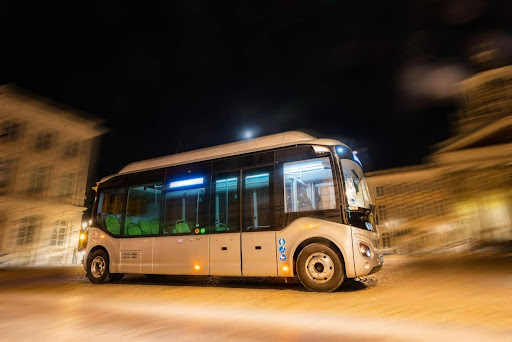To sign up for our daily email newsletter, CLICK HERE
On-demand buses use apps and algorithms to flexibly route vehicles based on passengers’ requested pickups and drop-offs in real time. This emerging model for mass transportation aims to improve access and efficiency. It’s particularly beneficial for the first and last mile commutes where regular transit does not directly serve. On-demand bus service represents an optimization of traditional service delivery through innovative use of technology.

On-Demand Bus Service Models
On-demand bus services employ different operational models to match demand. The two common models include:
Point to Point
Point-to-point on-demand buses let travelers go straight from one place to another within the coverage area. Riders specify their start and end points when requesting rides on the app. Vehicles then route to fulfill all trips most efficiently.
- Pro: Maximizes convenience of door-to-door travel.
- Con: May lack operational efficiency.
First-Last-Mile
The first-last-mile on-demand bus service model focuses on connections at the beginning and end of multi-modal trips. Buses circulate within set zones, transporting passengers to and from fixed transit stops like train stations.
- Pro: Coordinates with broader public transportation infrastructure.
- Con: Limited to designated pickup/drop-off areas and less convenient.
Together, these models demonstrate how on-demand fleets can adapt to community needs through technology-supported optimizations. Different approach impacts both rider experience and operational efficiency.
Three Advantages of On-demand Buses for Last-mile Transportation
Both passengers and service provider gain noteworthy benefits through innovative on-demand systems. These flexible bus on demand services for last-mile transportation deliver utility through optimized operations and satisfied riders. The key advantages include:
Cost-effective
For operators, an on-demand bus service for last-mile transportation offers cost benefits particularly where demand fluctuates. Dynamic routing utilizes vehicles productively versus hours spent underutilized on uncrowded schedules. Lower costs help agencies boost service in hard-to-reach places.
Convenient
Passengers enjoy the ultimate convenience of mobility on their schedule. Apps make requesting trips as easy as summoning a taxi. No more inflexible schedules – passengers control their commute. Furthermore, the real-time tracking of vehicles gives an added sense of reliability and reassurance for passengers.
Efficiency Promotion
An on-demand battery electric bus service for last-mile transportation improves efficiency for passengers too. Advanced algorithms configure optimal routes enabling shorter travel times. Gone are wasted moments waiting at empty stops; vehicles arrive on-call when needed. Real-time ETAs can further assure timely and predictable trips.
On-Demand Bus Service Examples
Transit on demand services are being tested on whether they are viable mobility solutions. Here are some examples:
m.connect in North East Scotland
m.connect is a example of on-demand bus service. Based in Scotland’s rural north, this service aims to alleviate transport barriers in isolated areas. The service was digitalised last year, which saw a huge success with early passenger journey figures up 30% in the first month. This significant uptick in usage indicates the positive impact of on-demand bus services.
Skånetrafiken Collaborates with Three Municipalities in Skåne
Skånetrafiken is also collaborating on a new on-demand bus service with three municipalities in Skåne, Sweden. The service is called SkåneFlex. Residents of Svalöv, Sjöbo, and Tomelilla can request rides via an app or phone and travel more easily than before. This on-demand bus service is expected to cater to varying travel needs across urban and rural areas in Skåne.
User perceptions of on-demand buses are positive. Riders value the flexibility that traditional models cannot match. Seen as eco-alternatives to personal vehicles, on-demand bus services provide optimized mobility. In the future, it may play a leading sustainable transportation role in communities worldwide.
Yutong’s Solution: E7S Tackles Last-mile Transportation Problems
Yutong Bus is one of the leading electric bus companies and transit manufacturers. For decades, it has built its reputation on reliable vehicles tailored to clients’ diverse mobility needs. A standout product comes in the form of its E7S. E7S is a marvelous micro mobility mini electric bus integrating compact size and large interior space. It is able to maneuver through the bustling narrow streets and populated residential communities, excellently primed for on-demand services.
The E7S Yutong electric bus conveys passengers efficiently and sustainably. Its compact size allows various environments yet retains passenger comfort. The following table highlights the E7S’s top features:
| Feature |
Benefit |
| Large Passenger Capacity |
Accommodates up to 30 commuters while remaining appropriately sized for varied streets. |
| Strong Adaptability |
A tight turning diameter of less than 17 meters helps the bus maneuver any route. |
| Long Endurance |
134 kWh battery enables traveling over 300km on a single charge. It can be fully charged within an hour. |
| High Safety |
Standards like YESS (the most advanced system for ensuring EV safety) means guaranteed passenger safety; monitoring systems track battery wellness. |
| Comfortable Design |
Low-floor entry, ample interior space, and smooth driving dynamics foster enjoyable trips. |
Overall, the E7S presents an intelligent choice for dependable on-demand transportation.

Conclusion
On-demand bus services represent an innovative way to optimize available transit resources. Leveraging technology, they can efficiently boost coverage for last-mile connections. Yutong stands at the forefront with dependable vehicle solutions supporting accessible transportation globally. Its wide range of offerings aims to thoughtfully evolve community travel towards increasingly personalized and sustainable options. Visit Yutong’s official website for more information.